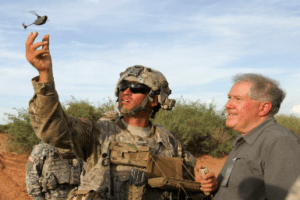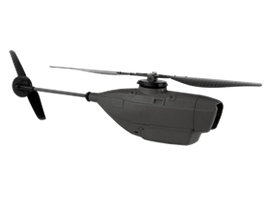
The Army’s Maneuver Center of Excellence at Fort Benning, Georgia has issued a preliminary set of requirements for pocket-sized drones. The Army hopes to have personnel on the ground equipped with what are being referred to as “Soldier Borne Sensors” (SBS)by 2018.
A “soldier borne sensor” is a small, fit in the palm of your hand, type drone that can be used to scout locations and assist in risk assessment. If you have happened to see “Eye in the Sky” the recent film starring Helen Mirren as a Colonel in the British Army, you will have seen a fictionalized example, a drone disguised as a large bug.
“We’ve had numerous studies as well as experimentation within our battle labs. We continue to see that soldiers are kind of lacking at the squad level for relevant information that’s immediately around them,” said Phil Cheatum, deputy branch chief of electronics and special developments at MCoE.
Such drones would provide army personnel with critical situational awareness (e.g. what’s over that hill.)
The specific requirements have not yet been finalized. However, features and functions that are being considered include:
- – a total weight (drone and controller) of not more than 150 grams.
- – capable of being deployed within 60 seconds and flying for 15 minutes on a single charge
- – be able to fly effectively at distances of up to 1.2km with line of sight and in winds up to 15 knots
- – contain a camera capable of identifying a human-sized object from from a distance of 50 to 75 feet.

Soldier borne sensors are not new. They have been used in the field by both British and Norwegian forces since 2012. One such drone is the PD-100 Black Hornet.
The technology and concept are not new. British and Norwegian forces have been using PD-100 Black Hornet drones since about 2012. The Army tested them last spring.
One current impediment is cost. According to the British Ministry of Defence, a 2013 Black Hornet contract for 160 units cost £20 million.
The demand for such a drone could open up the doors commercially for a start up to address that need. Longstanding defense contractors (e.g. Boeing) may not be nimble or quick enough to develop a solution to meet the armed services need in the time that they want it.
Frank Schroth is editor in chief of DroneLife, the authoritative source for news and analysis on the drone industry: it’s people, products, trends, and events.
Email Frank
TWITTER:@fschroth







[…] April, the army began to take steps to develop pocket-sized drones to equip soldiers with palm-sized drones that can scout forward locations and provide enhanced […]